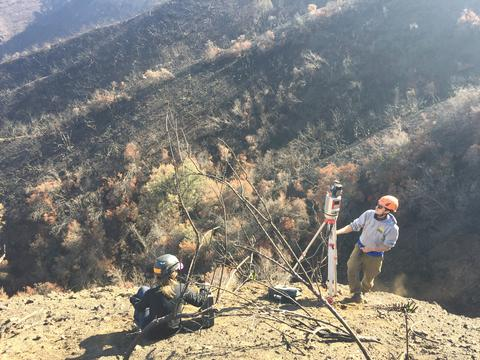Oct 23 2020
Wildfires continue to be risky even after the flames extinguish. According to a new study by researchers from the University of California, Riverside, even one brief rainfall after a fire can result in a hazardous landslide.
 Researchers in the field with a terrestrial laser scanning unit, December 2018, following first rainfall. Image Credit: Victoria Stempniewicz/U.S. Forest Service.
Researchers in the field with a terrestrial laser scanning unit, December 2018, following first rainfall. Image Credit: Victoria Stempniewicz/U.S. Forest Service.
When fire moves through a watershed, it creates waxy seals that don’t allow water to penetrate the soil anymore.
James Guilinger, Study Author and Environmental Science Doctoral Student, UC Riverside
Rather, the rainwater flows off the soil surface resulting in debris flows, which are fast-moving landslides that typically begin on steep hills and speed up as they move.
“The water doesn’t behave like water anymore, it’s more like wet cement,” Guilinger said. “It can pick up objects as big as boulders that can destroy infrastructure and hurt or even kill people, which is what happened after the 2018 Thomas fire in Montecito.”
Guilinger and his team of mentors and partners were keen to understand in-depth how several storm cycles impact an area that has been burned by wildfire, as Southern California is prone to get much of its rain in the same season.
The researchers went to the burn scar caused by the 23,000-acre Holy Fire near Lake Elsinore to study this phenomenon, and their findings have been reported in the Journal of Geophysical Research: Earth Surface.
“It’s only recently that technology has advanced to the point that we can directly monitor soil erosion at extremely small scales,” stated Andrew Gray, assistant professor of watershed hydrology and Guilinger’s advisor. Gray’s laboratory aims to comprehend how wildfire influences the movement of water and sediment via landscapes following wildfire.
Even with the newest technology, the data was not easy to acquire. To install their ground-based laser scanner, which uses infrared and visible waves to rebuild surfaces down to millimeter exactness, the team had to climb vertical hill slopes. They also arranged drones in partnership with Nicolas Barth, assistant professor of geomorphology, to zoom out and view up to 10 hectares of land after the storms.
They discovered that a majority of the soil in channels at the valley’s bottom between hill slopes eroded during the first few rains, even though the rains were comparatively mild. The channels tend to fill with material during the years between fires as well as in reaction to fire, with rain then triggering fast erosion resulting in the debris flows.
This proves the first storm events that strike an area are the most critical. You can’t really mitigate them at the source. Instead, people downstream need to be aware of the dangers, and land managers need hazard modeling tools to help them respond effectively and create a plan to catch the sediment as it flows.
James Guilinger, Environmental Science Doctoral Student and Study Author, UC Riverside
U.S. Geological Survey models include extensively available 10-m data for watershed slopes and data related to burn severity from satellite images to assess the magnitude and probability of debris flow that would happen under a specific amount of rainfall.
However, elevation data at the 1-m scale is becoming more extensively accessible in fire-susceptible areas like California. This more advanced data could allow the team to extract finer-scale data, such as differences in hill slope gradient and the shape of water channels that may have a large role to play in directing debris flows.
We can use data like these and the results of studies like ours to inform dynamically updating hazard models in the future. Rather than have a single set of predictions for the entire wet season, we may be able to update these models after each storm.
James Guilinger, Environmental Science Doctoral Student and Study Author, UC Riverside
Going forward, Guilinger will be using the funding from the federal Joint Fire Science Program to enhance current hazard models.
“This could prove very useful to land managers either immediately affected by or planning to mitigate the dangerous aftermath of wildfires,” he said.
Journal Reference:
Guilinger, J, J., et al. (2020) The Evolution of Sediment Sources Over a Sequence of Postfire Sediment-Laden Flows Revealed Through Repeat High-Resolution Change Detection. Journal of Geophysical Research: Earth Surface. doi.org/10.1029/2020JF005527.